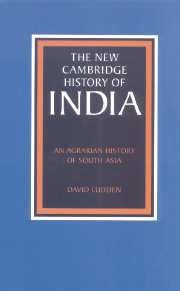3 - Regions
Published online by Cambridge University Press: 28 March 2008
Summary
In the fourteenth century, South Asia became a region of travel and transport connecting Central Asia and the Indian Ocean. This redefined the location of all its agrarian territories. In the wake of the Mongols, overland corridors of routine communication extended from the Silk Road to Kanya Kumari and branched out to seaports along the way. Connections among distant parts of Eurasia became numerous and routine. New technology, ideas, habits, languages, people and needs came into farming communities. New elements entered local cuisine. People produced new powers of command, accumulation, and control, focused on strategic urban sites in agrarian space. By 1600, ships sailed between China, Gujarat, Europe, and America. Horses trotted across the land between Tajikistan and Egypt, Moscow and Madurai. Camels caravaned between Syria and Tibet, Ajmer, and Agra. A long expansion in world connections occurred during centuries when a visible increase in farming intensity was also reshaping agrarian South Asia. In the dry, interior uplands, warriors built late-medieval dynasties, on land formerly held by pastoralists and nomads; and sultans established a new political culture, whose hegemony would last to the nineteenth century. Slow but decisive change during late-medieval centuries laid the basis formore dramatic trends after 1500, when agricultural expansion accelerated along with the mobility and the local agrarian power of warriors and merchants. Regional formations of agrarian territory came into being, sewn together by urban networks, during a distinctively early modern period of agrarian history, whose patterns of social power, agricultural expansion, and cultural change embrace the empires of Akbar and the East India Company.
- Type
- Chapter
- Information
- An Agrarian History of South Asia , pp. 113 - 166Publisher: Cambridge University PressPrint publication year: 1999

